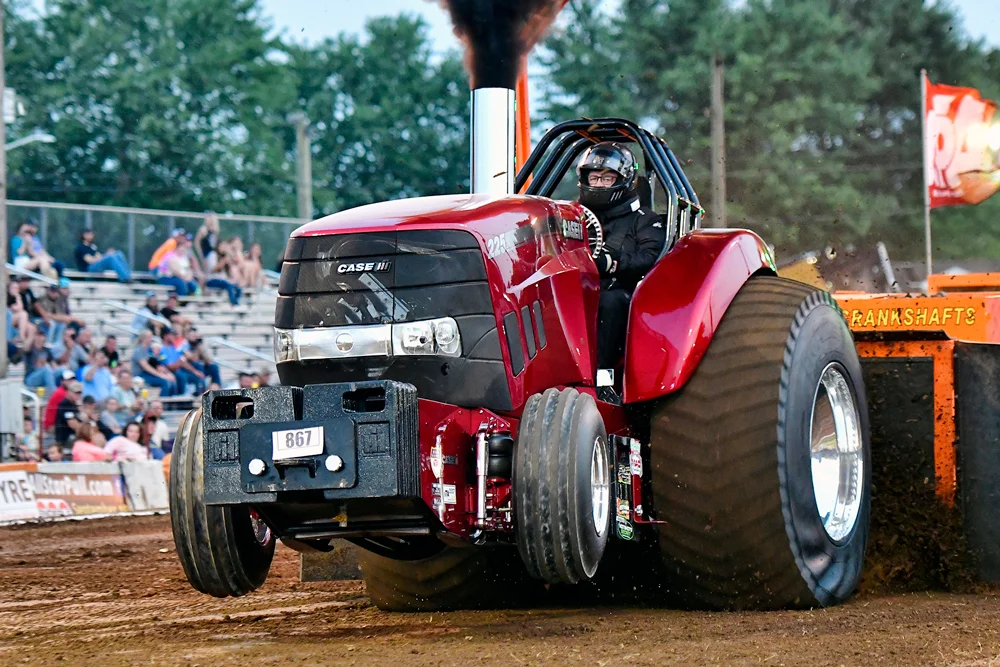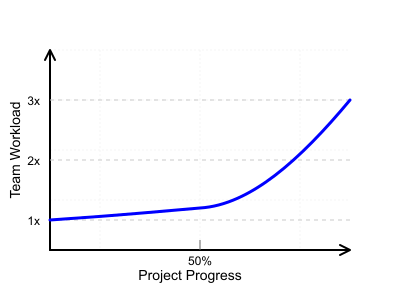
Marco is interested in managing the workload on his software development team, and has been presenting different ideas to the team for their consideration.
In this short story, Sarah stops by Marco’s office to talk about one of the ideas they discussed recently. Sarah wants to know more about what Marco has planned for the team.
Marco is happy to oblige and discusses one of the purposes of their team meetings - shaping, or managing, the worklod on the software group. They have a good discussion in which Marco uses the metaphor of a county fair tractor pull.
The metaphor makes sense to Sarah and she leaves the meeting with Marco with a task that interests her and better prepared to help her team.
Key take-aways and links to additional resources are at the end of this article. The YouTube video from “Smarter Every Day” is especially good!
Please note that all people and companies mentioned in this article are fictional.
Managing Software Group Workload: The Tractor Pull
Sarah knocked on Marco’s office door, finding him hunched over his standing desk, scope probe in hand and probing a development board of some kind. He looked up with a welcoming smile. “Hey Sarah, come on in. Just making some timing measurements on the new temporal assert macro we discussed after the meeting yesterday. With it, we will be able to use assertion checking to guarantee that we meet various timing constraints in our code.”
“Your timing is perfect, actually,” Sarah said with a grin, settling into one of the chairs across from his desk. “Yesterday’s discussion about assertion checking got me thinking. The technical approach makes sense, especially for a Class III device, but I’m curious about the bigger picture. What made you focus on this now?”
Marco lowered his desk and took a seat, clearly pleased by the question. “You know, that’s exactly what I was hoping someone would ask. You’ve probably noticed I’ve been pushing for more structured approaches lately - not just with assertions, but with our whole development process.”
Sarah nodded. “Yeah, like the new code review checklist and the automated validation scripts you added last month.”
“Exactly,” Marco replied, absently adjusting his monitor. “What I’m really trying to do is improve our flow - the rate at which we deliver quality work. And by quality, I mean something that will stand up to both FDA scrutiny and real-world use.”
“Flow of quality work?” Sarah leaned forward, interested. “Is this related to what you mentioned about process capability in the stand-up last week?”
“You caught that, huh?” Marco grinned. “Yes, it’s all connected. I’m trying to understand and control the sources of variation in our daily work. It’s not just about meeting deadlines - it’s about making our work more predictable and consistently high-quality. Both throughput and quality matter, especially with the kind of software we’re developing.”
Sarah tapped her pen thoughtfully against her notebook. “And controlling variation helps with that? I mean, I can see how it would help with testing, but…”
“Think about it this way,” Marco said, then paused. “Actually - random question: have you ever been to a tractor pull?”
Sarah’s face lit up with genuine amusement. “Okay, wasn’t expecting that pivot. But yeah, actually. Used to go to them when I was younger. The noise, the excitement…” She gestured expansively. “Watching those machines strain against increasingly heavy loads. It was quite a spectacle.”
“Perfect example!” Marco said enthusiastically. “Think about what happens during a pull. The tractor starts out strong, moving easily down the track. But as it moves forward, the weight shifts forward on the sled, making it harder and harder to pull. Eventually, most of the time, the load becomes too much. The engine’s roaring, smoke everywhere, but the tractor’s just spinning its wheels.”
“Making a lot of noise but not making progress,” Sarah added, starting to see where this was going. “Like when we hit that wall with the sensor integration last quarter…”
“Exactly,” Marco nodded. “And that’s what I want to avoid on the Denali project. We don’t want our work to become progressively harder as we go along, until we’re working flat out but barely moving forward.”
He moved to the whiteboard. “Mind if I sketch something? I want your take on this.”
Marco quickly drew a graph showing team workload over project progress, with a clear upward curve in the latter half:

“This is what I’ve seen happen too often in our industry. We start at a manageable workload - call it 1x - and it stays fairly steady through the first half. But then…”
Sarah studied the graph, her expression thoughtful. “The technical debt starts coming due?”
“Among other things,” Marco agreed. “What else do you think contributes to that curve?”
“Well…” Sarah considered, “There’s the obvious stuff - all those TODOs we leave in the code have to be addressed before we can ship. Can’t exactly explain those away during an audit.” She smiled wryly. “But it’s more than that. We start getting hardware prototypes that have their own issues. We need to build out testing infrastructure. And honestly? People get burnt out. Especially if they’re constantly fighting fires.”
“Good observations,” Marco said, picking up a green marker. He added a second, flatter line to the graph. It now looked like this:

“This is what I’m aiming for on Denali. See the difference?”
Sarah’s eyes narrowed as she studied the new line. “A controlled, consistent workload… Is that why you’ve been so insistent about documentation and test coverage from day one?”
“Part of it,” Marco confirmed. “The assertion checking strategy, clear documentation requirements, automated testing - they’re all meant to help us catch issues early and prevent technical debt from accumulating. It’s like having a lighter sled to pull.”
“But how do we know if it’s working?” Sarah asked. “I mean, beyond just feeling less overwhelmed?”
Marco set down the marker. “That’s where metrics come in. We track things like our defect discovery rate, implementation time for new features, stability of our test cycles. If these start trending up over time…”
“We’re pulling too heavy a load,” Sarah finished. “And I suppose our assertion failures during testing could be another indicator - especially if we start seeing them in areas we thought were stable.”
“You’re getting it,” Marco said, clearly pleased. “You know, Sarah, you seem to have a really good grasp on this. Would you be interested in leading a discussion about this with the team? Maybe at next week’s tech sync? I think you could help everyone understand how these technical practices connect to our broader goals.”
Sarah straightened, surprised but intrigued. “Really? I mean, yes, I’d love to. It would be a great opportunity to dig deeper into these concepts. Maybe we could use some real examples from our current work?”
“Absolutely,” Marco agreed. “Take some time to think about how you want to present it. The tractor pull analogy seems to resonate - maybe start there and then bring in specific examples from our project?”
“I’ll start putting some thoughts together,” Sarah said, standing up. “Thanks, Marco. This really helps explain the method behind what sometimes feels like madness,” she added with a small laugh.
As Sarah left his office, Marco felt a sense of satisfaction. He knew Sarah would do an excellent job sharing this perspective with the team. More importantly, she’d understood that good software engineering wasn’t just about writing code - it was about building sustainable processes that could stand up to the rigorous demands of medical device development.
Key Takeaways
Monitor Your Pull Weight: Like a tractor pull, software projects often start easily but can become progressively harder to move forward. Watch for signs that your team is “pulling a heavier load” - such as increasing defect rates or longer implementation times for similar features.
Control Process Variation: Predictable processes are manageable processes. Implementing consistent practices (like assertion checking and automated validation) from the start helps maintain steady progress throughout the project lifecycle.
Prevent Load Accumulation: Technical debt, deferred decisions, and incomplete documentation create a cumulative drag on productivity. Address issues early rather than letting them accumulate for the latter half of the project.
Measure What Matters: Track meaningful indicators of project health:
Rate of new issue discovery Implementation time for features Stability of testing cycles Assertion failures in previously stable areas
Build Sustainable Practices: Good software engineering isn’t just about writing code - it’s about creating processes that can consistently deliver quality while standing up to regulatory scrutiny.
Additional Resources
- TRACTOR PULLS: It’s Not What You Think - Smarter Every Day 276
- An interesting and fun video full of inside baseball on tractor pulls!
-
https://productive.io/blog/workload-management/
- The Hospital and Clinic Improvement Handbook by Boaz Ronen, Joseph S. Pliskin, and Shimeon Pass (2006)
- While focused on healthcare delivery, this book applies Lean and Theory of Constraints principles to regulated environments and provides valuable insights for medical device development teams.
- Accelerate: The Science of Lean Software and DevOps by Nicole Forsgren PhD, Jez Humble, and Gene Kim (2018)
- Particularly relevant are chapters 4 and 11, which discuss technical practices that help maintain consistent delivery pace and quality in software development.
- The Phoenix Project: A Graphic Novel about IT, DevOps, and Helping Your Business Win by Gene Kim, Kevin Behr, and George Spafford (2013)
- While not specific to medical devices, this business novel effectively illustrates how unmanaged work-in-progress leads to increasing organizational drag - similar to our tractor pull metaphor.
- Technical Debt in Practice: How to Find It and Fix It by Neil Ernst, Ipek Ozkaya, and Robert Nord (2020)
- Provides practical approaches to identifying and managing technical debt, with specific attention to regulated environments where quality requirements are strict.
About John Sambrook
I enjoy the work that I do at Common Sense. I especially enjoy meeting and working with people that want to improve the systems that matter most to them. Through careful work and how we show up we all have a tremendous opportunity to do good in the world.
I hope you enjoy what you find here. Feel free to contact me with any questions or just for a relaxed discussion..
— John Sambrook